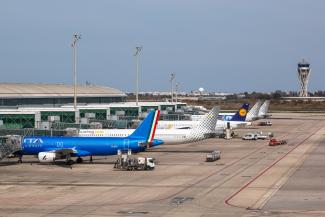In the last 20 years, according to official aeronautical agencies in Latin America, passenger traffic and aircraft operations has doubled. But this growth comes with a downgrading in the service level due to serious affectation in the overall performance of airport operations, mainly due to the increase in both airside and landside congestion. This pressure in the infrastructure becomes the trigger to expansion projects, but those are low speed responses to demand while congestion levels keep rising. Operations and resources’ efficiency optimization is the natural mitigation tool to this issue.
Routine airport operations generate large amounts of data, enabling the analysis of their performance. In this regard, it is key to monitor the airport operations’ status. Performance Monitoring Frameworks comprising a set of Key Performance Indicators (KPI’s), comparable to other airports and traceable throughout time, might be a first step to new predictive and much more accurate models that enhance operation and allows setting improvement objectives in the short/medium term.
Main airports in Latin America are seeking innovative solutions, such as A-CDM, that can enhance the operations predictability. The first underlying element that sets the foundation to achieving collaboration is always the establishment of a performance framework in order to identify bottlenecks and assess any improvement. The development of this framework could provide valuable information that, compared to a suitable reference, can bring to light a large number of improvement areas: punctuality, efficiency, predictability, safety, environment, etc. Performance monitoring framework example
Performance monitoring framework example
When talking about airport operations efficiency, the optimum is reached when the adherence of the operation to the planning is maximized. In this optimal situation, the utilization of airport scarce resources can be efficiently managed to obtain the highest productivity. Predictability is the KPA that drives the ability of the operation to stick to the initial plan, and so this makes it the primary focus of latest initiatives focused on collaboration and data sharing, such as A-CDM.
The benefits that these methodologies provide are reflected in the results of some of the most congested European airports (where A-CDM is widely implemented), when compared to their Latin American counterparts. In Figure 2, comparable airports in terms of number of operations and level of congestion are showing different distributions for different phases of the operation. While punctuality figures are in the same range or slightly better at LatAm airports, the time variability in different phases of the aircraft process at the airport show relevant deviations, affecting predictability. This effect is observed throughout the region, leading to under usage of assets by adding buffers to mitigate deviations from the plan. 
 Comparison between congestion levels and the distribution of different phases of the aircraft operation at airports for two representative airports in Europe and LatAm
Comparison between congestion levels and the distribution of different phases of the aircraft operation at airports for two representative airports in Europe and LatAm
As a conclusion, COVID-19 outbreak crisis opens an unprecedented time where all airport stakeholders will have an opportunity window to test and implement those changes in the search of efficiency improvements that were endlessly postponed under the pressure of a congested operation. The first step towards a solution is simple: understanding the airport’s operational performance by setting up a Performance Monitoring Framework.











































































